On a perfect starlit evening this past November, the world’s most acclaimed singer, Adele, emerged from a two-year, self-imposed absence from performing and recording to appear in Adele One Night Only, a primetime television special filmed at the Griffith Observatory in Los Angeles in front of an intimate, celebrity-studded audience. She wore a spectacular gown designed by the House of Schiaparelli. Since the legendary label re-emerged a decade ago after a hiatus of more than a half-century, A-list stars such as Lady Gaga and Beyonc have flocked to 21, Place Vend me in Paris to be measured for a one-of-a-kind creation. And it is nothing short of magnificent that the legacy of one of the most iconic, artistic, visionary designers in the history of haute couture, Elsa Schiaparelli, has been revitalized.
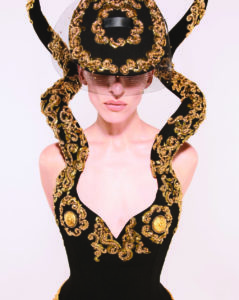
Our story takes us to Paris before and after the two world wars, when Gabrielle “Coco” Chanel (1883-1971) set the standard for haute couture while her contemporary and greatest rival, Italian expatriate Elsa Schiaparelli (1890-1973), dynamically defied the norm. That Coco was born in a charity hospital to a French laundress and itinerant street vendor, and Elsa at the Palazzo Corsini in Rome to an aristocratic Neapolitan family, is important if you are to the understand the genesis of modern fashion. Born into poverty, Coco’s currency for success was the French franc while Elsa capitalized on fashion as art. Both women exploited their empyrean eye for fashion—Coco’s, classic and understated. Elsa’s . . . not so much. For the purpose of this article, we focus on vibrant, defiant, independent Elsa Schiaparelli, whose uninhibited bravado and fearless defiance of the acceptable established her among the great artists of the Surrealist Movement—and cost her the recognition Chanel usurped in the annals of 20th century fashion history.
Rebellious even as a child (prone to pranks, she caused an early end to an important dinner party her parents were giving when she hid under the table and released a large jar of fleas) she resisted her mother and father’s pressure to marry a Russian aristocrat and fled to London, never again to return home. There, within days of their meeting, she married a Polish-Swiss lecturer of spiritual mysticism and together they immigrated to America. Shortly after, Elsa gave birth to her only child but the marriage didn’t last. The couple separated in 1922, and Elsa relocated to Paris with her young daughter. In time, she opened a small atelier on the rue de l’Université, where she specialized in hand-knit, geometrically patterned sweaters of her own design. Her singular European style captured an American flare that appealed to affluent fashionistas and by November, her signature black-and-white, square collar sweater with a trompe l’oeil red bowknot woven in became all the rage on both sides of The Pond. It was so successful, that Elsa expanded into a full line of sportswear and soon she was offering daytime and evening wear.
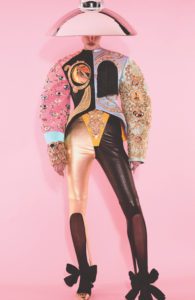
The decade between 1930 and 1940 was Elsa’s most creative period. She was firmly ensconced among the Paris circle of Dada and Surrealist artists that included artists Jean Cocteau, Leonor Fini, Alberto Giacometti, Marcel Duchamp, most intimately with Salvador Dalí,
who would become her lover, and photographer Man Ray, with whom she had a long-term association. Inspired by her friends, she interpreted her art with fashion as her canvas, creating thematic collections, such as “Stop Look and Listen” (1935), “Music” and “Paris” in 1937, “Pagan” and “Circus” in 1938, and “Commedia dell’arte” (1939).
By 1932, Elsa had 400 seamstresses in her employ with an annual output of 8,000 garments at her new salon, on 4 rue de la Paix. In 1935, she relocated to the prestigious heart of Paris, at 21 Place Vendôme, where ready-to-made orders—thanks to enormously successful commercial arrangements with American department stores and specialty shops— now exceeded 10,000 garments a year. She expanded her collections to include hats, furs, accessories, and—coveted today by collectors—magnificent costume jewelry. She launched a perfume line in 1936 with “Shocking.” The bottle was fashioned in the shape of a curvy woman’s torso by artist Leonor Fini, who took her inspiration in her friend’s workroom when she came upon the tailor’s dummy of one of Elsa’s best clients—Hollywood bombshell Mae West.
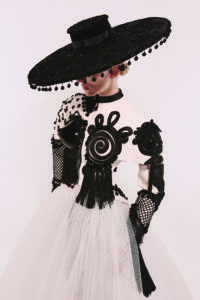
Among her most notorious creations was the “Lobster Dress” (1937), a simple white silk evening dress on which a giant lobster was painted by Salvador Dali below the crimson waistband almost to the hem of the floor-length skirt. The dress was photographed at the Château de Candé by legendary photographer Cecil Beaton, where it was worn by Wallis Simpson shortly before her marriage to Edward VIII of England, who assumed a backseat in history when he abdicated the throne for “the woman I love.” That same year Elsa collaborated with her friend, French poet, novelist, and filmmaker Jean Cocteau, to create an evening coat with shoulders and bodice covered with hot-pink (Elsa’s signature color) appliqued roses and, along the back, the embroidered profile of two lovers puckering up for a kiss. This masterpiece that combines art with fashion is now part of the permanent collection at the Victoria & Albert Museum in London.
The “Tears Dress” followed in Elsa’s 1938 “Circus Collection,” a pale-blue column-style evening dress made of fabric printed with a Dali trompe-l’oeil pattern and worn with a thigh-length veil with pink appliqued “tears” lined in magenta. And that same year, in another collaboration Elsa designed the demur “Schiaparelli suit” between 1938-1939, featuring oversized statement buttons sculpted by Swiss sculptor Alberto Giacometti.
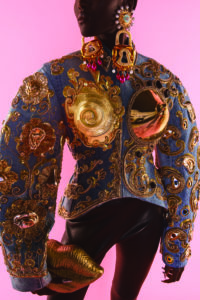
Elsa had forged strong ties in the United States during her six years living there and as the storm clouds of World War Two gathered upon Europe’s horizon, she decided to leave Paris and return to New York. There she devoted her time to the war effort as a nurse’s aide at Bellevue Hospital. After the War, she returned to Paris to resume business but by now, a younger generation of designers led by Cristobal Balenciaga and Christian Dior had taken over the fashion limelight. Dior proclaimed his style the “New Look” but in actuality the young designers collections were more conventional. Nonetheless, the new generation in fashion overtook Elsa’s creations in popularity and in sales. Unwilling to adapt to changes, the House of Schiaparelli declared bankruptcy in 1954 and Elsa retired to the home she had built in Tunisia. At that same point in time, Coco Chanel, the keen businesswoman, had grown her fortune to $15 million—the equivalent of over $150 million today. Elsa Schiaparelli died, age 83, in Paris. But her label did not.
In 2007, Italian businessman Diego Della Valle acquired the Schiaparelli brand. Through a carefully constructed revival and hyper-exclusive business strategy under the direction of Marco Zanini, The House of Schiaparelli was nominated for a return to the most elite of elite trade associations, Le Chambre Syndicale de la Haute Couture in January of 2014.
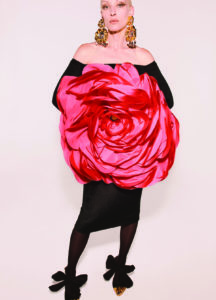
Illustrated here is The House of Schiaparelli’s “Matador Couture” Fall-Winter 2021/2022 Collection. “I found myself wondering, again and again: What if you combined a little Manet; a little Lacroix; a little 1980s; a little 1880s; a little matador; a little space alien; a little Ingres; a little shimmer; a lot of color? The answer is this, my fourth couture collection, ‘The Matador’: A collection that honors Elsa’s vision but isn’t in thrall to it,” Daniel Roseberry, artistic Director of The House of Schiaparelli explained. The palette is iconic Elsa—black, gold, her signature pink, a wave of sky-blue, and flashes of gold and silver. The unabashed Dali-esque applications of gilt breasts accentuating a stylized matador’s jacket or corset, the reprisal of Giacometti-inspired buttons on a fitted tunic coat with Elizabethan sleeves, and boughs of appliqued roses forming like a trellis over the bodice and sleeves of a black wool crepe minidress with duchess satin insert; the insanely exquisite attention to detail, embroidery, and tailoring and fabrics patterned with Dali eyeballs that stare right through you are purely Elsa. The energy, the courage, and the bravado that was hers has been captured in this collection as much as the fashion. Roseberry may be her living protege, but he is also a master in his own right. He has added his own hallmark to the Schiaparelli crown and with it, an excitement, creativity, and a style that is clearly his own. Indeed, to speculate that Elsa Schiaparelli would be proud is the highest compliment—and well deserved.
By Pearl Lustre

